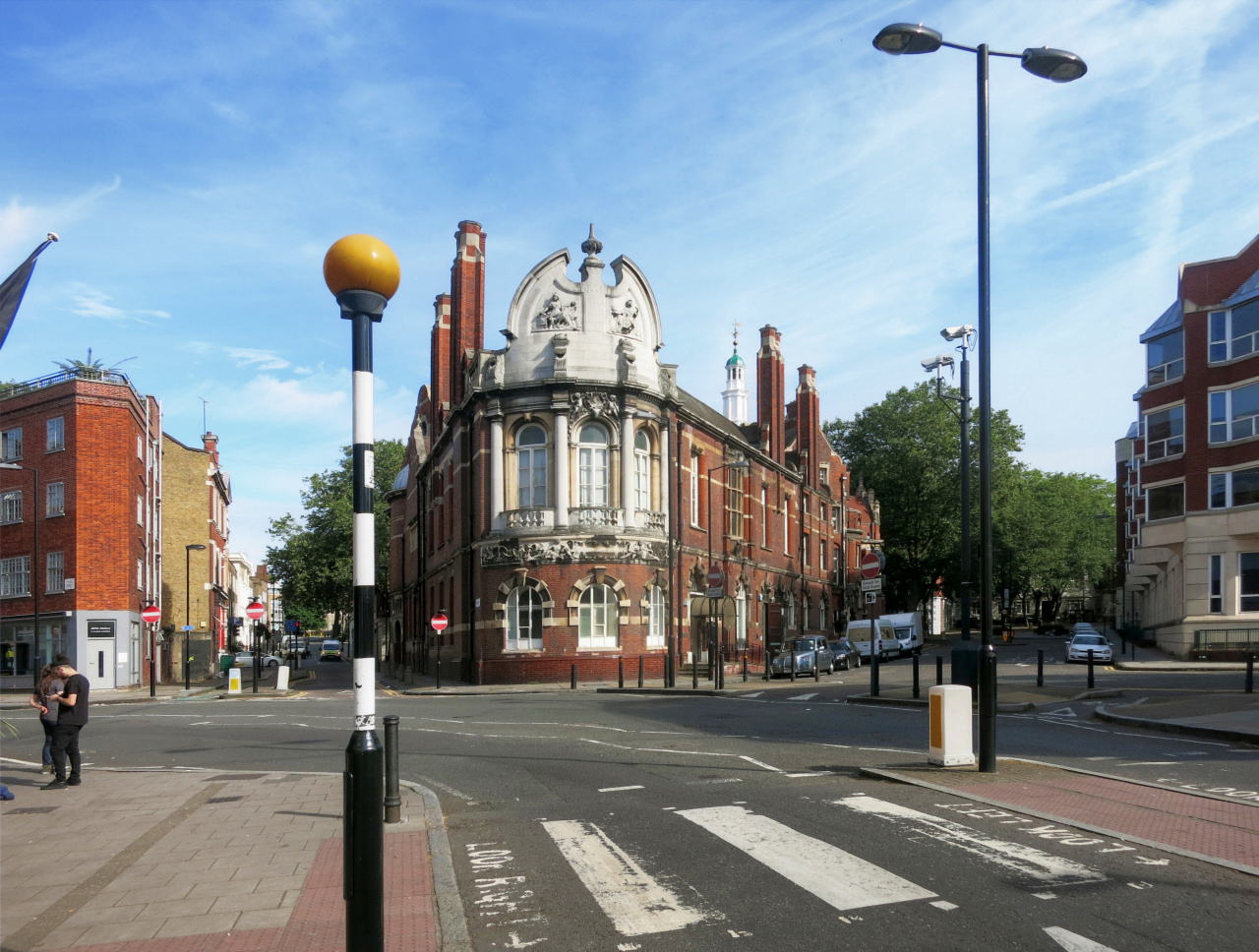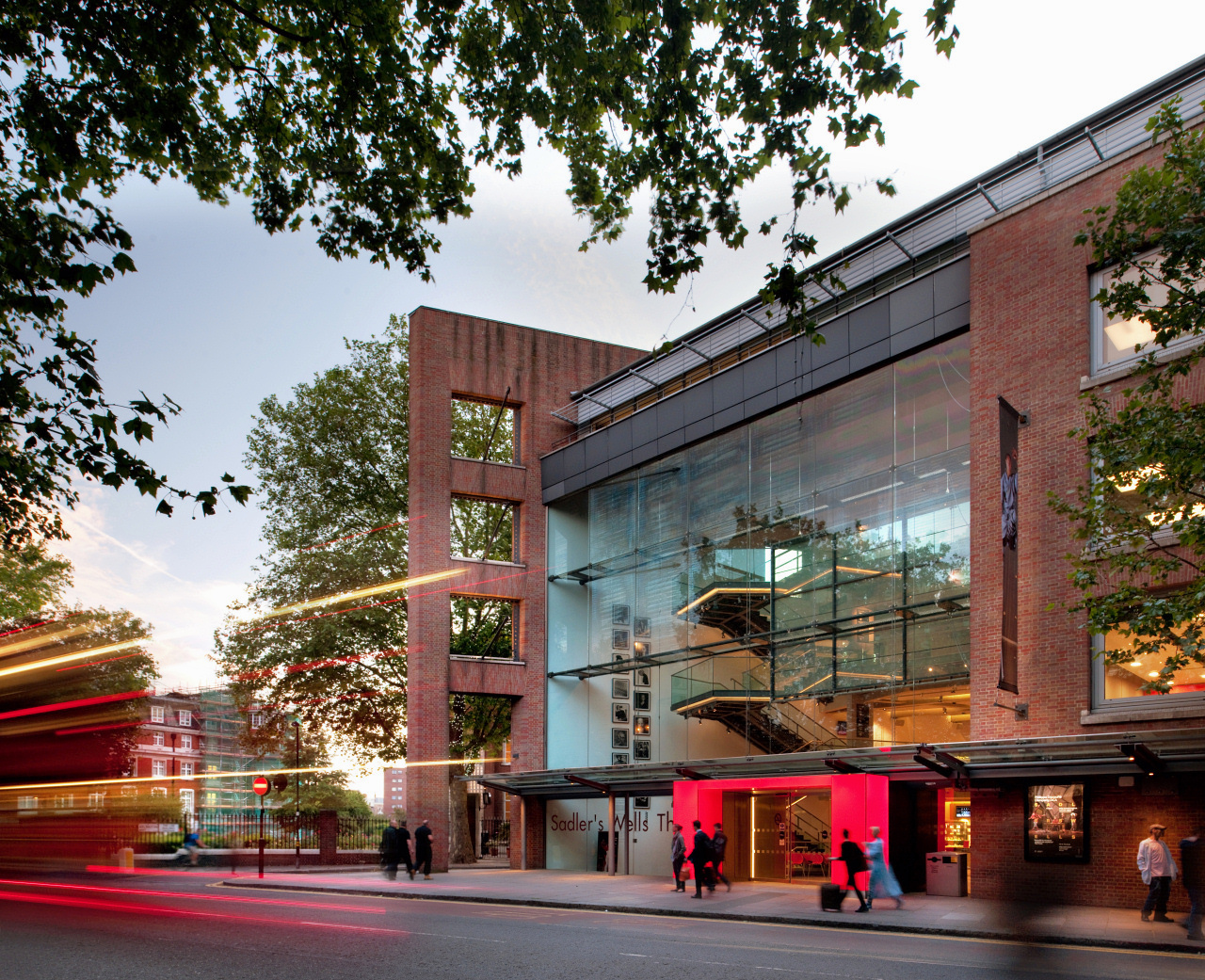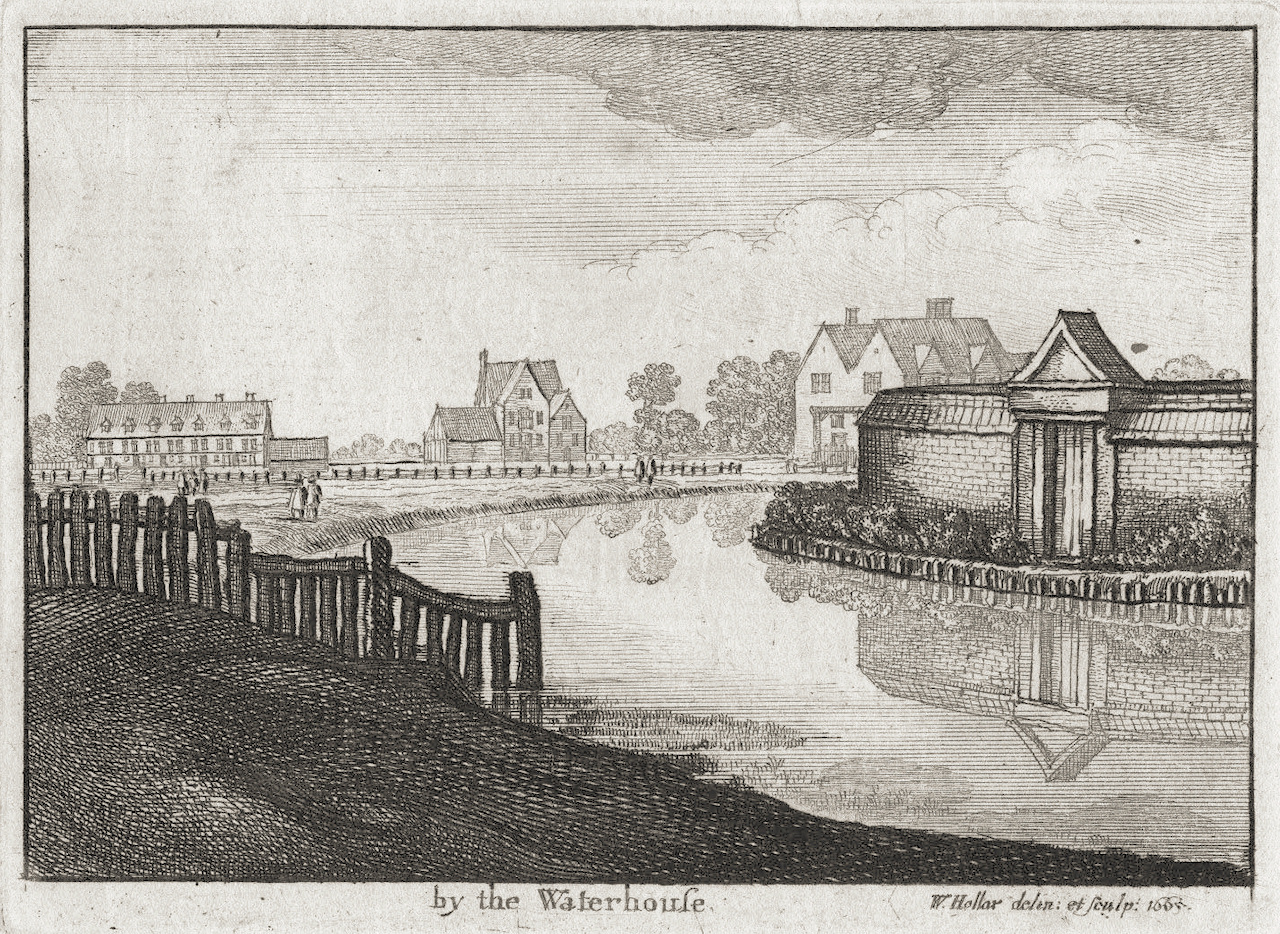Updated: 16 July 2019 |
|
Walk page: Click to view |
Appendix to the Islington walk
MORE ABOUT THE AREA’S HIGHLIGHTS
In-depth profiles of three of the most significant places mentioned in the Clerkenwell to Islington walk.

FINSBURY TOWN HALL
This unusual building, built on the intersection of six streets in the heart of Clerkenwell, was once the town hall for the Borough of Finsbury, which was absorbed by the neighbouring Borough of Islington in 1965. It’s Grade II* listed and registered with English Heritage as a building of ‘great historical importance’. It was unveiled in 1895 by Prime Minister Lord Rosebery, (who gave his name also to Rosebery Avenue, the main road that runs alongside, which had only been built a month before).
One of the reasons the building is architecturally so important are the many Art Nouveau features, both internally and externally – quite radical considering the age of the building.
In 2007 the building was acquired by the Urdang Academy, originally established as a ballet school by the dancer Leonie Urdang in Covent Garden and now a highly regarded performing arts school. They carefully restored the building, paying special attention to the wonderful features of the Great Hall and Council Chamber and these are now used for a variety of events, including weddings, banquets and much else.

SADLER’S WELLS
Sadler’s Wells was the second theatre to open in London after the Restoration (the Theatre Royal in Dury Lane being the first). It was opened by Dick Sadler in 1683 and known then as a ‘musick house’ and has been a place of entertainment ever since.
Shortly after opening, an ancient medicinal well was discovered in the grounds and the enterprising Mr Sadler was quick to promote the water’s health-giving properties. The spa soon became as popular an attraction as his musick house, hence it got the name of Sadler’s Wells. He claimed that amongst many ailments the iron-rich water would be effective against ‘dropsy, jaundice, scurvy, green sickness and other distempers to which females are liable – ulcers, fits of the mother, virgin’s fever and hypochondriacal distemper.
By the beginning of the 18th century, interest in ‘taking the waters’ at Sadler’s Wells had dropped and entertainment was again the main attraction. Everything from jugglers to rope dancers, wrestlers to stage-fighters – even dancing dogs and a singing duck trod the boards there!
With the Theatre Royal in Covent Garden and in Dury Lane only opening during the autumn and winter, Sadler’s Wells began a summer entertainment season, which became very popular. In the late 1700s Thomas Rosoman became manager and built a new theatre that began to feature opera.
The famous Regency actor, comedian and dancer Joseph Grimaldi became a Sadler’s Wells star thanks to developing the first English pantomimes here. It was he who introduced the custom of the ‘pantomime dame’, as well the tradition of audience participation that continues to this day.
In 1844, Samuel Phelps took over and he turned Sadler’s Wells into ‘… a theatre as it ought to be – a place just representing the work of our great dramatic poets’. When he left some twenty years later Sadler’s Wells repertoire returned to variety and melodrama and went into decline, eventually being converted into a roller-skating rink and later a prize fight area.
After re-opening as a theatre in 1879, it became more of a music hall, but again became increasingly run-down and eventually closed in 1915.
A public appeal was made in 1925 for funds to set up a charitable foundation to enable Sadler’s Wells to be bought for the nation, and the committee responsible for raising the money consisted of some of the leading lights of politics, theatre and the arts.
By the early 1930’s, when the theatre reopened, a ballet company had been started, which was the beginning of the Sadler’s Wells connection with dance. Since then it has enjoyed widely varying degrees of success, with everything from ballet to Gilbert and Sullivan being featured.
In 1998 a new theatre opened – the contemporary and extremely well-designed building you see today – with facilities that are still lacking in many London theatres – for example sufficient toilets for ladies!

THE NEW RIVER COMPANY
As London’s population continued to grow, the supply of fresh water became more of a problem. For centuries people had obtained their water from wells, springs, streams or of course the River Thames, but with no other way to dispose of rubbish it was easy to just chuck everything, from toilet waste, household rubbish to dead dogs, into the nearest watercourse. Hardly surprisingly, it meant that over the years they had become increasingly polluted. Not only that, but due to the increased use, many were drying up.
This resulted in an increase in the number of outbreaks of waterborne disease, particularly typhoid and cholera. Eventually things got so bad that under pressure the City of London Corporation came up with a plan to construct a channel to bring freshwater in from springs in Hertfordshire, some twenty or so miles to the north. Parliament passed the plans and the job of organising the project was eventually passed to Hugh Myddelton, a unique individual in that he was a Member of Parliament, a banker, goldsmith and engineer. The company that was formed to undertake what at the time was a major feat of engineering was given a Royal Charter and Hugh Myddelton was appointed as its first governor.
Together with Robert Mylne, who he had appointed as Chief Engineer, Myddelton came up with the idea of cutting an artificial channel from the fresh spring waters at Amwell in Hertfordshire to Clerkenwell, a distance of some 28 miles.
Myddelton managed to persuade business colleagues, friends and others to form a partnership – they called themselves the “Adventurers’ and they managed to raise about half the money needed. However, they struggled to raise the other half and the City of London Corporation refused to help, saying the project was now financially too risky (never mind the poor people drinking polluted water!) Disputes with landowners along the route caused further problems and, with money running out, Myddelton appealed to James I for his help. He agreed, though in return for putting up the other half of the money he demanded a 50% share of the profit – probably fair enough I’d say!
Having eventually raised the necessary finance, work commenced in 1609. This northern part of Clerkenwell was chosen as the place where the New River would terminate. The site needed to be on the more impervious London clay, which provided a better ‘bed’ for a reservoir than the free-draining gravel of southern Clerkenwell. It needed to be on ground lower than the springs in Hertfordshire, from where it flowed, yet still high enough above most of London to enable the water to continue to flow by gravity. A channel, or canal, 10 feet wide and 4 feet deep was dug and, whilst it had to be kept as level as possible, it obviously needed a gradient to ensure the water would flow by itself down to Clerkenwell. That gradient was just five inches in the mile. However, there were a number of hills along the route so, in order to maintain those levels, the channel ended up being nearly forty miles in length – twice as long as the ‘as the crow flies’ distance.
It took five years for the channel, which they called the ‘New River’, to be constructed, which finally opened in 1613, terminating at the ‘New River Head’. It emptied into a small pond named the ‘Round Pond’, which was previously just a ‘duck pool’ and enlarged to become a small reservoir where the water could be stored. Once it was full, the outward flow of water was controlled through a cistern and stopcocks in the basement of the Water House, which I explain next, on the southern edge of the ‘pond’. From here the water flowed out in pipes made from hollowed out elm trees down into the City of London, providing it with its first ever supply of fresh water.
The official opening in 1613 was performed by Myddelton and was recorded as follows: “the flood-gates flew open, the streame ranne gallantly into the cisterne, drummes and trumpets sounding in a triumphall manner.”
The ‘Water House’
To house the equipment needed and supply offices and accommodation for staff, a building called the Water House was built adjacent to the Round Pond. Seemingly, no money was spared on its construction or its ‘Oak Room’, where the company would hold prestigious meetings and dinners. Although built as far back as the 17th century, its carved oak interior (hence the name) is beautifully preserved, and its Late Renaissance style was regarded by many as an architectural gem, as it still is today, which I explain shortly.
Growing competition in the 18th century from other companies that were being formed to supply water meant that it was important for the New River Company to be able to supply more water and at a more regular pressure to other parts of London. To help achieve this they built an additional ‘higher level’ reservoir, called the Upper Pond half a mile or so to the north in a site in Claremont Square, adjacent to the Pentonville Road, which we walk past on the walk. This additional ‘head of pressure’ allowed the company to then begin supplying districts further away, one of which was London’s West End. However, it did of course mean that water had to be first pumped up there and initially this was done by a windmill (the base of which is still visible in the grounds) but this didn’t prove to be particularly successful, so a steam engine was installed around 1768.
Eventually the original fresh water springs in Hertfordshire weren’t sufficient to supply the growing needs of the New River Company and they began to take water from the River Lea as well, which by the 1850’s was supplying nearly all of it.
By 1819 the company had replaced its original wooden pipes with cast-iron mains.
Metropolitan Water Board
An Act of Parliament that was passed in 1902 created a Metropolitan Water Board to take over London’s various private water companies, including the New River Company. The importance of the New River Head in the history of London’s water supply was reinforced when, in 1913, the board decided to locate its headquarters there. By 1920 they desperately needed more space and the original Water house was demolished, and a new headquarters called the New River Head built on the site, the building you see today.
The famous ‘Oak Room’, which I previously mentioned, was fortunately regarded as being so special that it was carefully taken from the original position on the ground floor of the old Water House and carefully reassembled on the first floor of the new building, a truly remarkable example of the early architectural preservation. The Oak Room is open for the public to see on special occasions, such as the annual London Open House weekend in September.
Privatisation and Thames Water
When in 1989 the water industry was again privatised and Thames Water took over the responsibility for supplying Greater London, Berkshire, Wiltshire and even parts of Kent with water, they set up their new headquarters in Reading, which meant the Metropolitan’s existing headquarters in the New River Head was then largely redundant. However, due to its historical importance and considerable expanse of open green space, building on the land was prohibited, and instead it was decided to turn the existing buildings into residential accommodation.
Also included in the redevelopment was the Water Testing Laboratory that had been built in 1938 by the Metropolitan Water Board to monitor the biological, bacteriological, chemical and chlorination aspects of London’s water, which was carried out by a team of seventy technicians. This was closed down and the building converted into thirty-five flats in 1998.
Over time the operation grew so much that it covered around seven acres, though there is little sign now of any that. The numerous filter-bed sites were gradually covered over with lawns and gardens, although on the site today there is still the base of an 18th century windmill that once helped pump water into London. As this didn’t prove to be practical, a steam pumping engine was then installed and the subsequent ‘engine house building’ that once accommodated it is also still there.
Amazingly, the site is still part of London’s water supply and there’s a small pumping station and a deep access shaft connected to the London Thames Water Ring Main, a 50-mile concrete tunnel that circles London, carrying some 250 million gallons of water.
Clearly Sir Hugh Myddelton was a remarkable man, and later in the walk you see a statue of him that was erected on Islington Green.